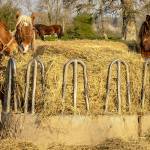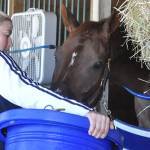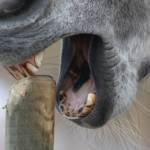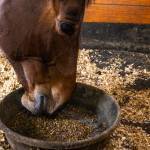Forage for Horses: Round-Bale Feeder Selection Affects Costs, Quality, Health

Different round-bale feeders produce more waste than others, unnecessarily increasing feed-associated costs. Hay contamination, loss of quality, and consumption time should also be considered when purchasing a feeder. One study conducted at Southern Illinois University compared two common types of round-bale feeders.*
“Round bales are a convenient way to feed large groups of horses, and they require less daily labor than feeding small square bales,” said Ashley Fowler, Ph.D., a nutritionist for Kentucky Equine Research.
“If placed directly on the ground, hay waste from round bales can be quite high as it is trampled and contaminated by feces and urine. Additionally, uncovered hay is prone to nutrient leaching and mold growth during wet periods, further increasing hay waste,” she added.
Various types of round bale feeders partially circumvent these problems. Some conventional feeders feature a large metal ring with loops protruding from the top that allow each horse a place to feed. The loops can be angled inward to further prevent hay loss. Other feeders are roofed and feature gravity-controlled grills that lower as the bale is consumed so the hay is always maintained at an appropriate height off the ground.
Researchers compared these types of round-bale feeders, allowing mares confined to a drylot to feed from each type (five mares per group) for 48 days. The wasted hay found on the ground outside the feeder was collected, dried, and weighed to calculate waste.
During the study period, six round bales were consumed by each group, about one bale every eight days. Each round bale weighed approximately 1,200 lb (547 kg). The amount of hay wasted by the conventional feeder was 486 lb (221 kg) per bale (about 40%), whereas only 119 lb (54 kg) of hay per bale was wasted using the gravity-controlled feeders (about 10%). Thus, the gravity-controlled feeders saved 367 lb (167 kg) of hay per bale or 2,427 lb (1,003 kg) during the 48-day study period. This equated to a financial savings of $161.42 over the course of the study when using the gravity-controlled feeder.
Because there was less wasted hay, mares in the gravity-controlled feeder group gained 9.7 lb (4.4 kg) per week during the study. The mares in the conventional feeder group only gained 0.9 lb (0.4 kg) per week.
“The initial body condition of the mares was not reported in the study, so we don’t know if they needed to gain weight or not. However, depending on the energy needs of the horses being fed and their voluntary hay intake, allowing free access to forage may cause unwanted weight gain. Offering a lower-quality hay, controlling the amount of hay fed, or increasing exercise are good options for curbing weight gain,” explained Fowler.
Bear in mind that lower-quality hay is not synonymous with poor-quality hay.
“Lower-quality hay simply contains lower digestible energy, greater fiber concentrations (often seen as NDF and ADF on a forage analysis), and lower nonstructural carbohydrates. Lower quality does not mean weed-contaminated or moldy hay,” she said.
Horses offered an all-forage diet, particularly if being fed a lower quality hay, should also be offered a ration balancer to meet essential mineral and vitamin requirements.
*Hyde, K.A., A. Altman, R. Banasek, M.O. Gastal, and E.L. Gastal. 2023. Efficiency of round bale feeders: Comparison of Tombstone versus Hay Saver. Journal of Equine Science 34(2):51-54.








